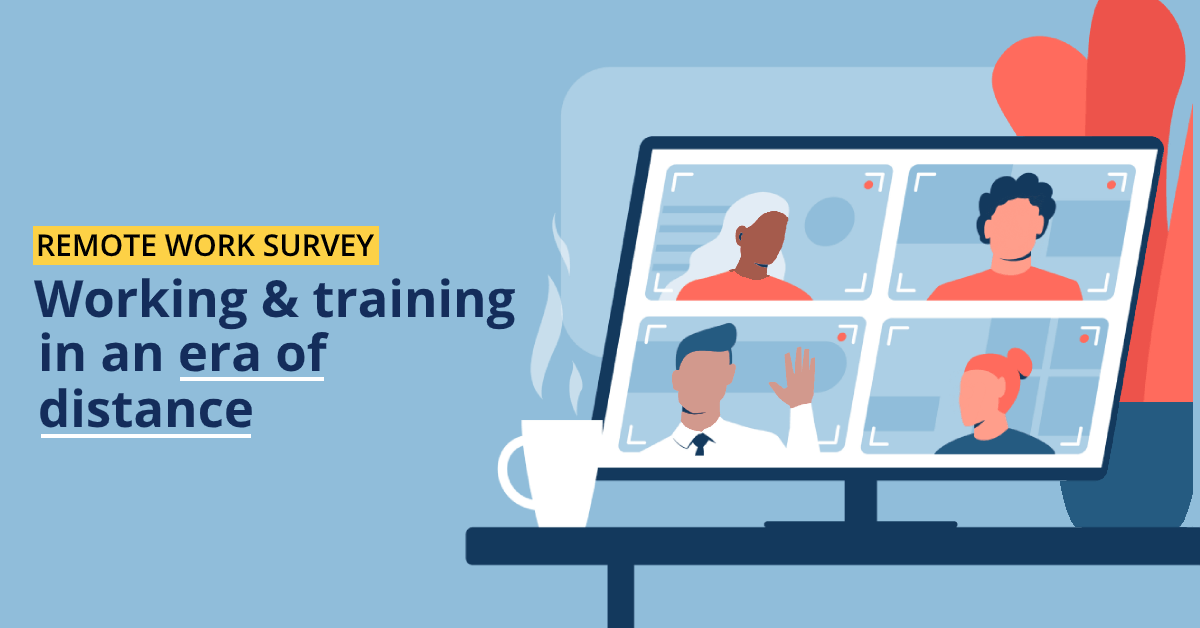- Remote work training: Who wants it, and who gets it?
- What does remote workforce training look like?
- Does training your remote employees really make a difference?
- Work from home, life, and the pursuit of training
- Different learners, different needs, different methods of delivery
- Remote work, training, and retention: Why it all matters
- Remote training and career advancement: An undeniable link
- Remote work statistics — how work from home has changed from one year ago
- Work from home statistics: Putting faces to the numbers
*This is an updated post. For TalentLMS’s 2019 Remote Work Statistics, click here.
With the rise of the COVID-19 pandemic over the last year, millions of people have transitioned to remote work, not out of preference, but of necessity. In this sudden transition, many companies made what was once merely a dream for remote work enthusiasts a reality overnight.
In the 2019 work-from-home statistics report, TalentLMS surveyed 500 remote employees to gain a better understanding of how they work and train, what remote work looks and sounds like, and, of course, why employees had chosen it.
But as remote work quickly became the norm and not the exception, we decided to take another look at how remote work training and work habits have changed.
Above all, we wanted to answer one critical question: does offering your remote workforce training opportunities make a difference in their performance, happiness, and company loyalty? Turns out it does.
To answer these questions in depth, we surveyed 1000 respondents across the U.S. While all of them are working remotely, half have received training from their employers in the last 12 months, and the other half have not.
Read on to discover the ways that training your remote workforce can make a dramatic difference. More specifically, keep reading to learn:
- Remote work training: Differences between those who want it and those who get it
- What does remote workforce training look like?
- Does remote work training make a difference in perspective and performance?
- Work from home, life, and the pursuit of training
- Different learners, different needs, different methods of delivery
- Remote work, training, and retention: Why it all matters
- Remote training and career advancement: An undeniable link
- Remote work statistics — how work from home has changed from one year ago
Remote work training: Who wants it, and who gets it?
Before diving in to the differences that training makes, let’s address the obvious: do the remote employees who haven’t received training from their employers want it? According to the survey results, 78% do.
But what type of training, exactly? The kind that will help them expand their skills, both hard and soft.
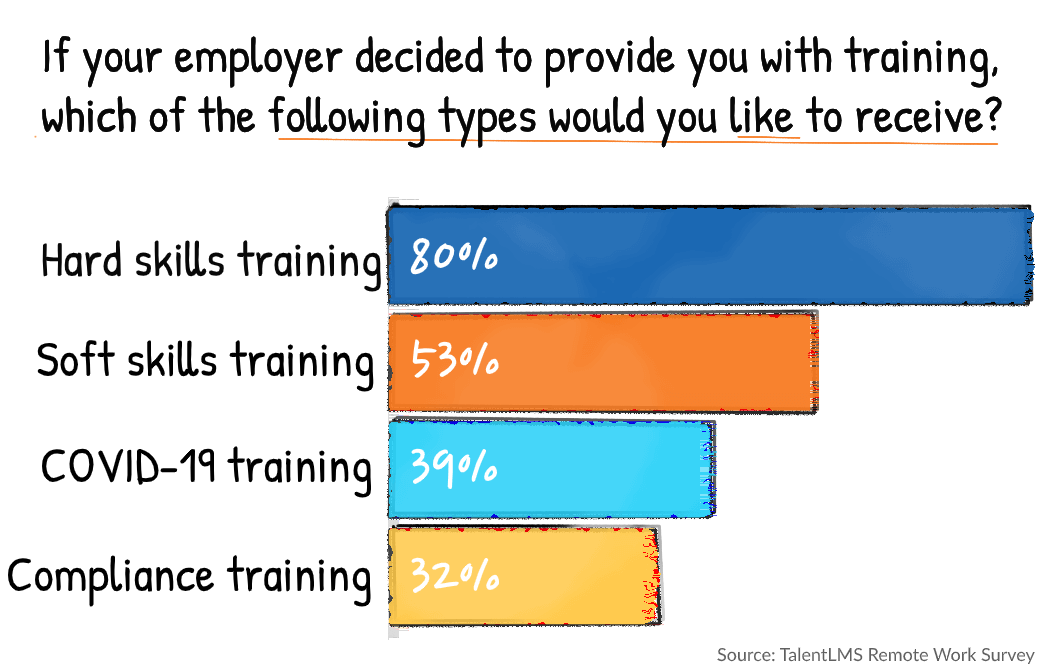
Depending on the age of the respondent, there is a difference in the rate at which they report wanting hard and soft skills training.
Eighty-six percent of younger respondents aged 18-34 want to receive hard skills training, and 50% want soft skills training. Meanwhile, 77% of respondents aged 34 and up want hard skills training, and 54% want soft skills training.
That being said, 22% of all respondents said they were not interested in receiving additional training. When asked to explain why, nearly every single person said they don’t believe they need it.
What does remote workforce training look like?
For those employees who have received training from their employers, it’s worth exploring what topics and skills have been covered.
In contrast with the reported preferences of the non-training group, hard and soft skills were the third and fourth most frequently covered topics, after COVID-19-related and compliance training.
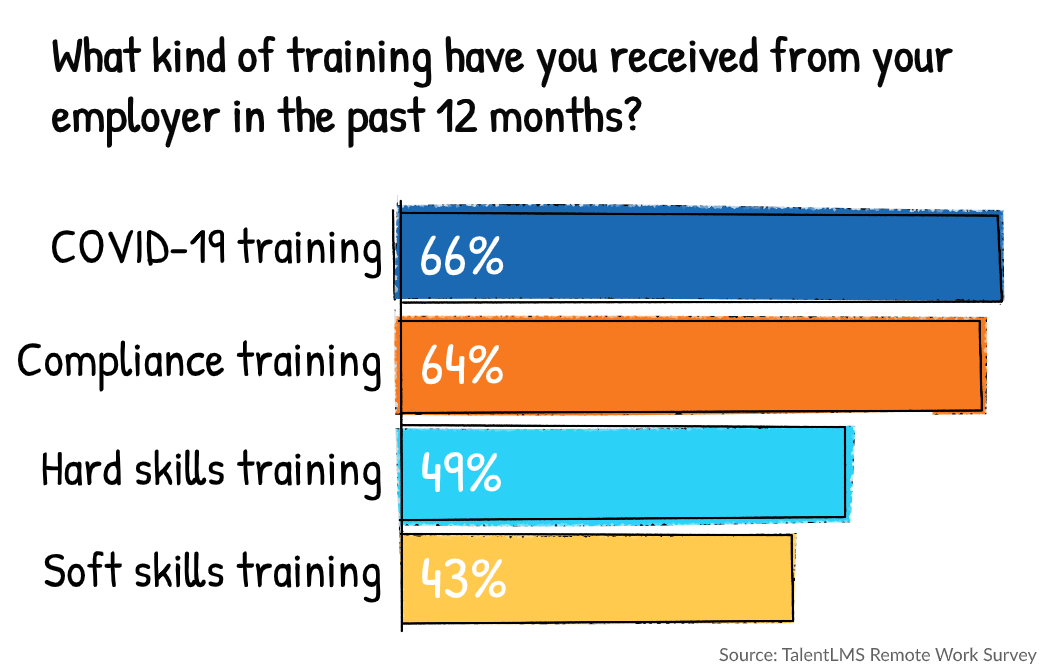
Finding the time to actually complete training has always been a perpetual challenge both for employees themselves, but also for managers looking to crush those course completion rates.
When we asked remote employees if they ever complete training outside of their working hours, 82% said yes. What’s encouraging, though, is that 45% specified that they do so because they enjoy it, not because they have to. That number increases to 50% when we look specifically at respondents aged 35 and up, which may indicate that this age group is most engaged with the topics and training employers are currently providing.
Twenty-five percent of all respondents said they complete training outside of working hours because they don’t have time for it during their day. And that number increases to 32% in respondents aged 18-34. This difference in response rate between the two age groups suggests that younger remote workers may feel that they are busier throughout their workday than some of the more experienced people in their company.
Regardless of age, working remotely blurs the lines between work and home, with many people extending their working hours beyond their established 9-5. So, would remote employees be more likely to complete training if they had dedicated time during their workday for it? For 87% of people, the answer is yes.
So, when it comes to boosting completion rates, the solution may be as simple as making sure your employees have enough time for it.
Does training your remote employees really make a difference?
Every manager and employer’s goal is to support their employees as much as they can, allowing them to perform at their very best. When you’re all in an office together, you can check in with your staff, help eliminate distractions, and answer questions on the spot.
But when your employees are working remotely, there’s a lot less you can control. That’s why training becomes such a valuable tool for reaching these members of your team.
Differences in perspective
Ask any manager, and they’ll probably tell you that their teams could always benefit from additional training. Ask employees if the people they work with need more training, and they’ll probably say yes, as well.
But what do remote employees have to say about themselves? Do they recognize their own need for training?
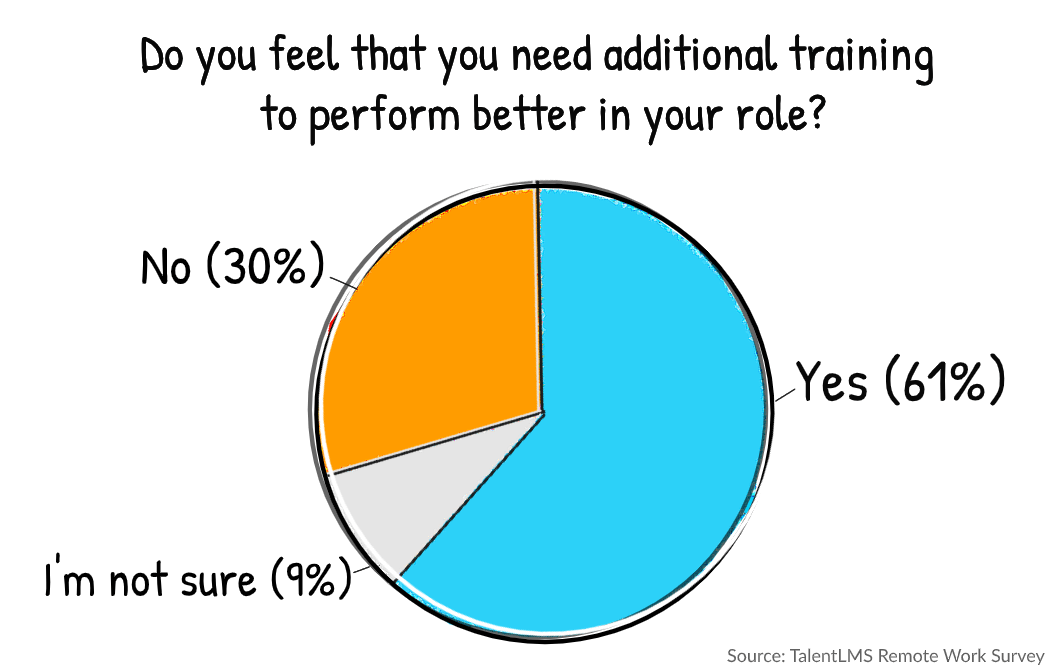
The short answer is yes: 61% of respondents (including those that already received training) said that they need more to do their jobs better, and another 9% said they’re unsure.
One respondent even specified: “I’m doing well, but there may be skills or techniques I’m not currently aware of that could help me do better.”
The overwhelming majority (88%) of all surveyed employees said that access to training is “somewhat” or “very” important to them. More specifically, 93% of respondents in the group with training say it is “somewhat” or “very” important, and 83% of those without training said the same.
So why do employees who already receive training value it at a higher rate?
While we might expect that more remote employees who are missing training would deem it more important than those who already have it, these numbers speak to the importance of showing your people that you’re investing in them.
When employees are given the chance to grow and develop their skills, they realize how valuable it is in hindsight. The true value of training is realized after employees have the chance to put their new knowledge into practice.
Once you’ve invested in your people, they’re in a much better position to really appreciate the value of this investment.
Differences in performance
In addition to the direct impacts that training has on employees’ skills and abilities, are there any positive effects on people’s day-to-day performance? We asked all 1000 respondents to rate themselves on a scale of 1 to 5 on points like productivity, time management, communication, and work/life balance.
Remote employees that had received training rated themselves a 4 or 5 at consistently higher rates than those that received no training.
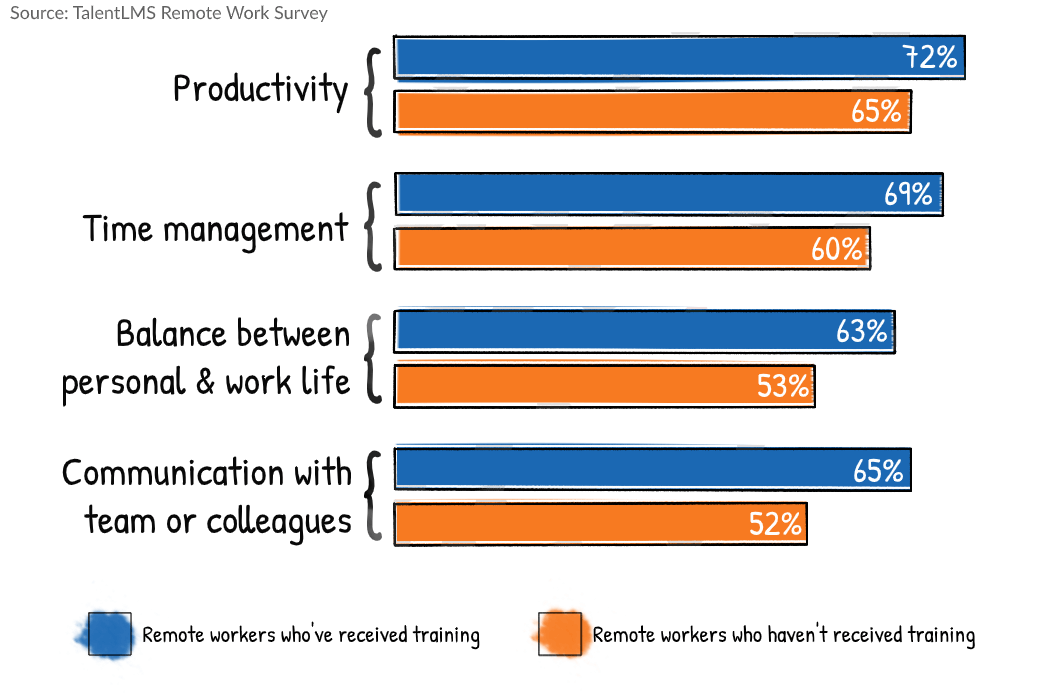
The benefits of remote employee training extend beyond job performance. Employees who’ve received training also rate themselves higher than their counterparts without training when it comes to happiness while working from home and feeling valued by their companies.
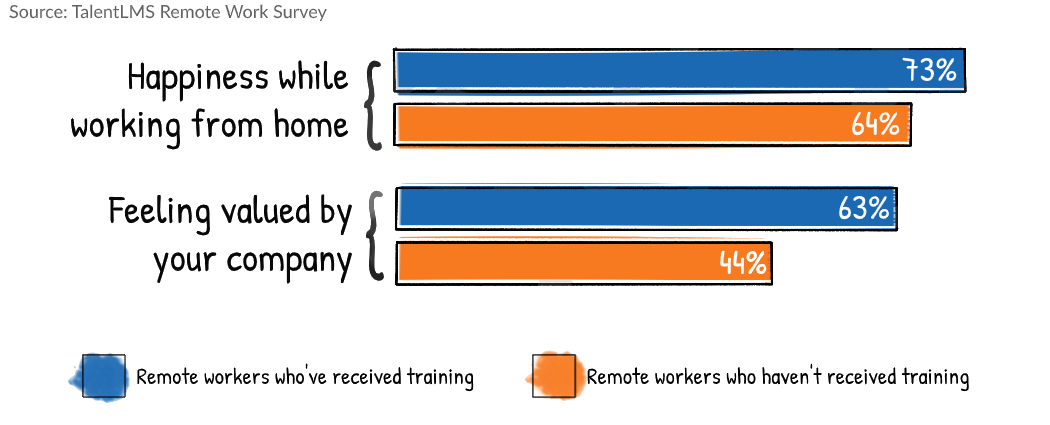
So, as the work from home statistics suggest, the presence or absence of training has far-reaching consequences. Remote employees with training feel more productive, manage their time better, have better communication, and maintain a better balance between their work and personal lives.
Those without training from their employers are not only less happy when working from home, but they feel less valued by their companies. Both of these factors play a significant role in employee satisfaction and, therefore, retention.
Train and retain your remote workforce with TalentLMS.
Boost employee satisfaction and performance in clicks!
Easy to set up, easy to use, easy to customize.
Work from home, life, and the pursuit of training
The COVID-19 pandemic has left many remote employees with more free time, both during and after the workday. And since the survey shows that the majority of these employees value training highly (and a sizable percent even enjoy it), it’s time to see if they had pursued any on their own since the start of the pandemic.
The results revealed that the overwhelming majority of respondents (78%) had pursued training opportunities on their own, regardless of whether or not their employers have provided them with any.
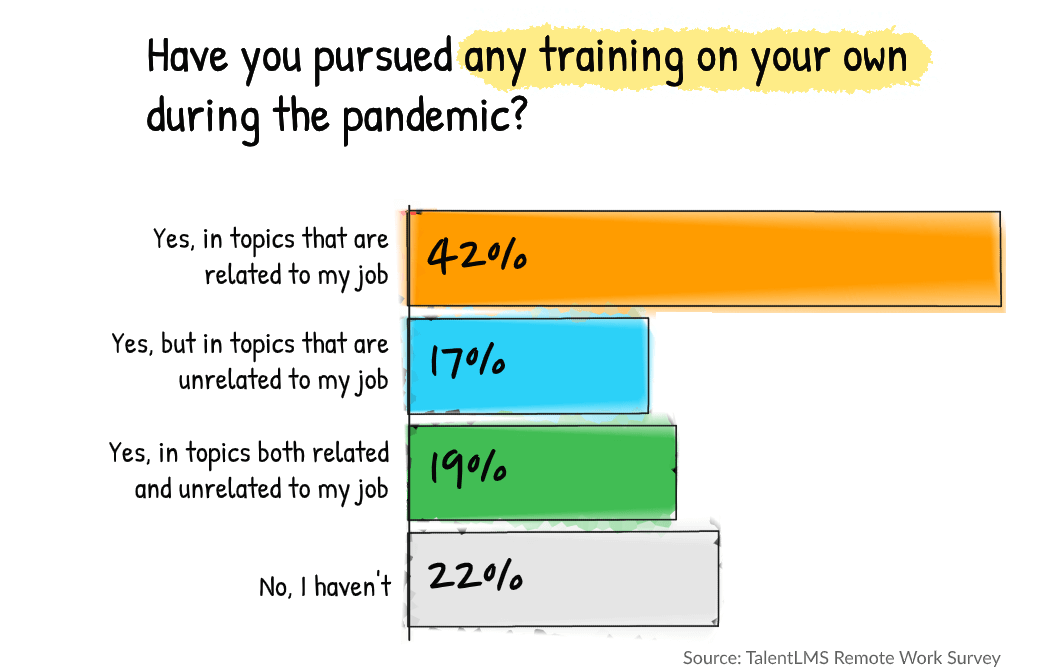
When we compare the results of the two surveyed groups we see that exposure to training matters.
In fact, respondents whose employers have provided them with training sought out additional training on their own more consistently than those that hadn’t been provided with any:
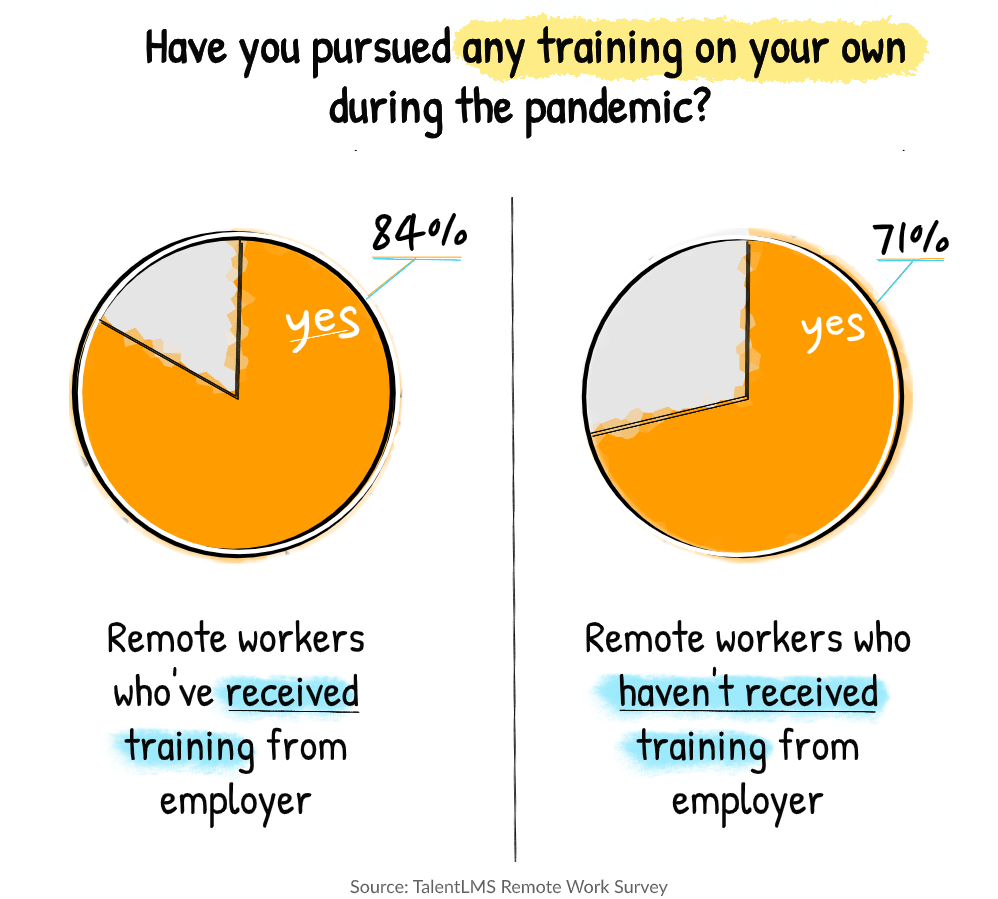
More specifically, of those without employer-provided training:
- 31% sought out courses in topics related to their job
- 20% in topics unrelated to their job
- and 20% in both
While of those who had been provided training by their employer:
- 53% spent time learning about topics related to their jobs
- 14% in topics unrelated to their jobs
- and 17% in both.
These numbers are encouraging to employers because they show that investing in training opportunities for your people results in increasing returns. Not only are remote employees willing to reach for training on their own, but those that had already received some from their jobs were more likely to pursue more on their own.
The result: a little bit of training can go a long way.
Different learners, different needs, different methods of delivery
While providing any type of training is certainly better than providing none, focusing on the way it’s delivered will help ensure that everyone has an optimal learning experience.
People learn differently, and remote employees are no exception. Our respondents were asked to categorize themselves based on the type of learner they are. These are their responses:
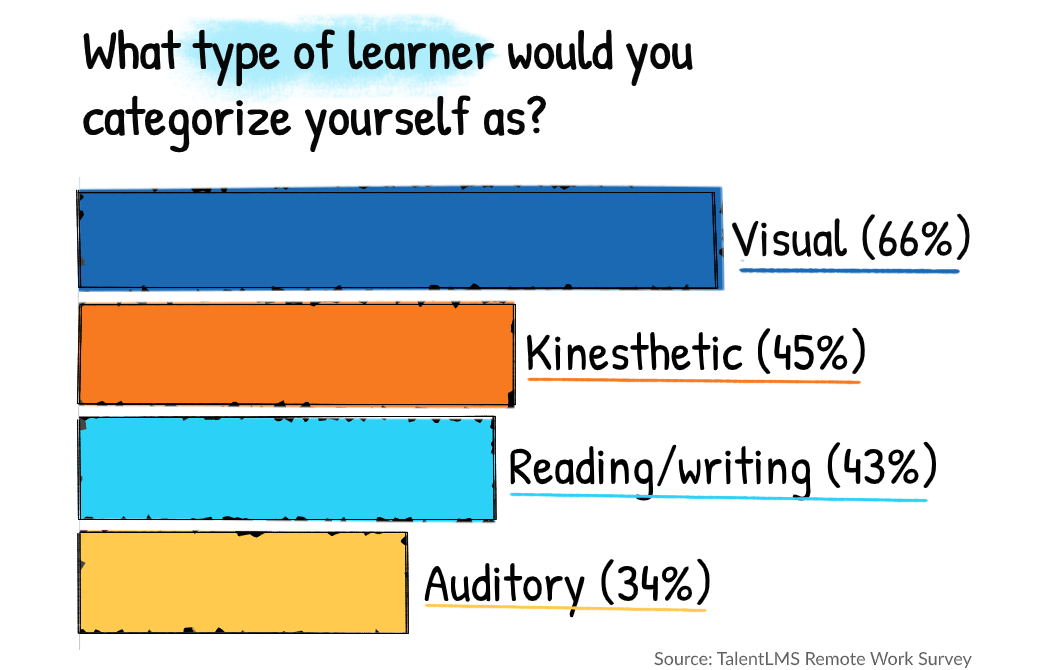
Most people are not just one type of learner, so survey respondents were allowed to select as many groups as they felt they belong to. As expected, the most commonly selected type was visual, with 66% of respondents reporting themselves as this kind of learner.
This is good news for employers because there are many easy and affordable ways of training your people online that are effective for visual learners.
Remote work, training, and retention: Why it all matters
As work from home has become the new normal, employers and employees alike have been wondering if, and how things will ever go back to the way they were. Will offices make a comeback, or is remote work here to stay by popular demand?
And more importantly, is making remote work a permanent option the key to employee retention?
When all 1000 respondents were asked if they were thinking of leaving their employers within the next year, 35% said yes, regardless of if they had received training or not. Nevertheless, some common issues were cited across both groups.
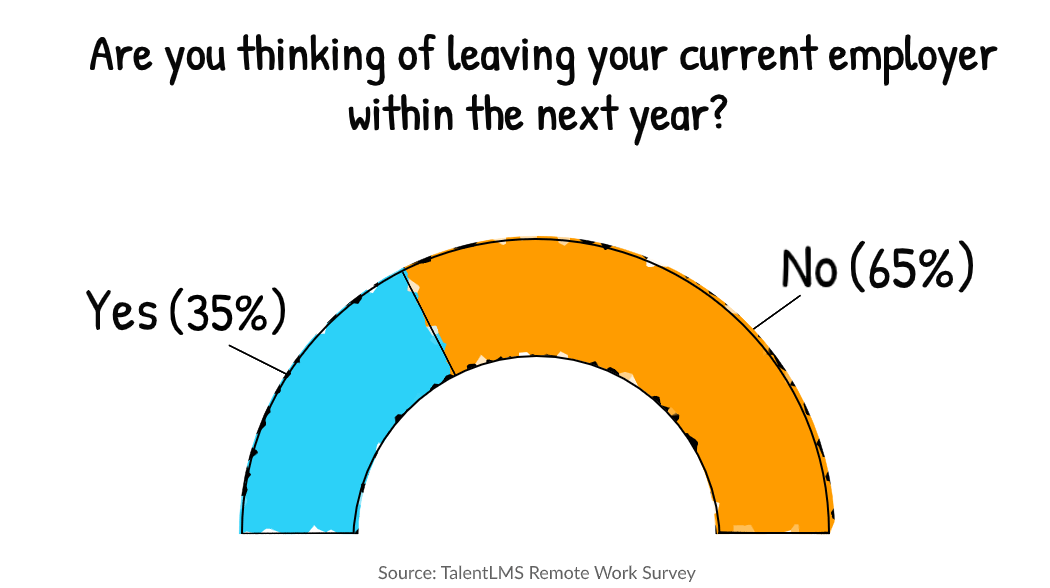
When those who had responded “yes” were asked to provide their reasoning, here are what some respondents had to say:
- “I feel like with the pandemic, there’s not a lot of room for growth anymore”
- “If they’re not going to offer proper training, I might as well just leave”
- “Lack of proper training, and lack of recognition”
- “There really isn’t much room for advancing”
Those interested in leaving largely said they felt undervalued by their employers and didn’t see any room for advancement within the company. Meanwhile, many who responded that they are not interested in leaving said it is because they love their jobs, are well paid, and want to remain financially stable. Employer-provided training also made a difference, with 76% of employees who had received soft skills training reporting that they have no plans to leave the company.
What didn’t come up in their responses? The option to remain remote. But we also covered that.
Respondents were asked if they’d be willing to take a 10% pay cut in exchange for being allowed to continue working remotely full time, even after the pandemic has passed. Neither group bought into the idea of working remotely if it comes with a pay cut.
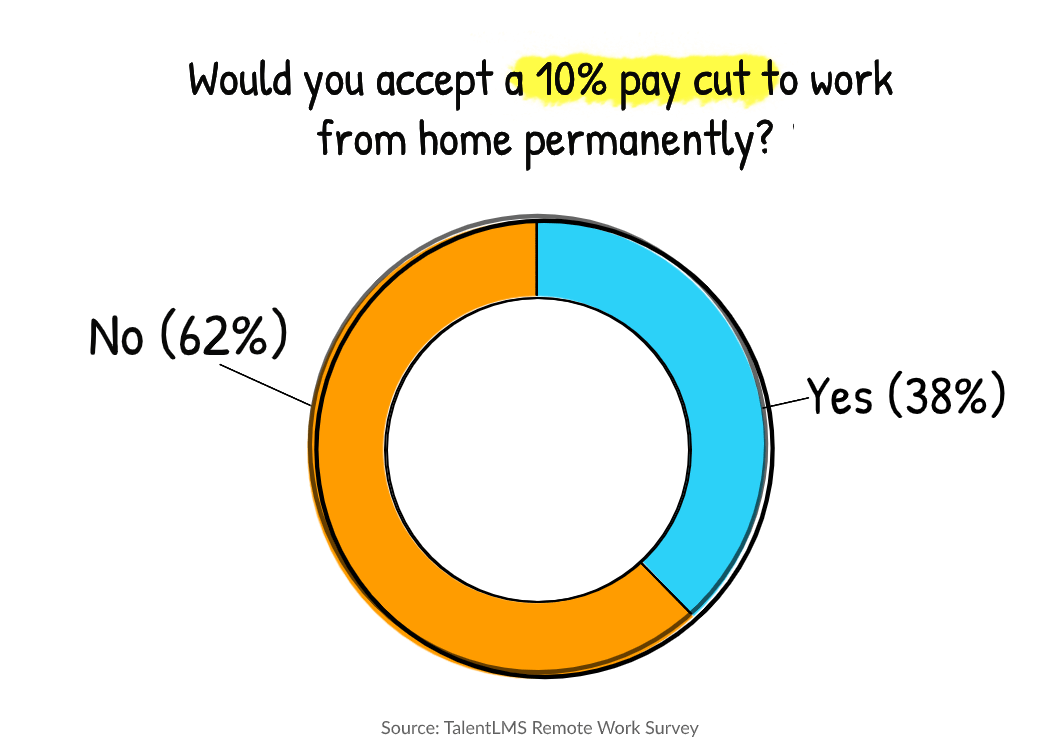
But the data does suggest that the presence or absence of employer-provided training makes a difference here.
Forty-five percent of those that had received training said they would be willing to accept the pay cut, while only 30% of those without training said the same. This difference suggests that employees who feel they’re being invested in by their companies are willing to give up financial compensation for other perks or work-related benefits, whereas those who feel less valued are unwilling to do the same.
But is training the only reason why remote employees decide to stay in the long run? Or is it that training comes with the advancement that people are looking for?
Remote training and career advancement: An undeniable link
Of all the job elements that this piece examines in remote employees both with and without training opportunities, there was one place where it made the biggest difference: promotions.
We asked both groups if they had been promoted in their company in the last 12 months, and the results were staggering. Fifty-one percent of employees who have been provided with training have also been promoted, while only 29% of those without employer-provided training said the same.
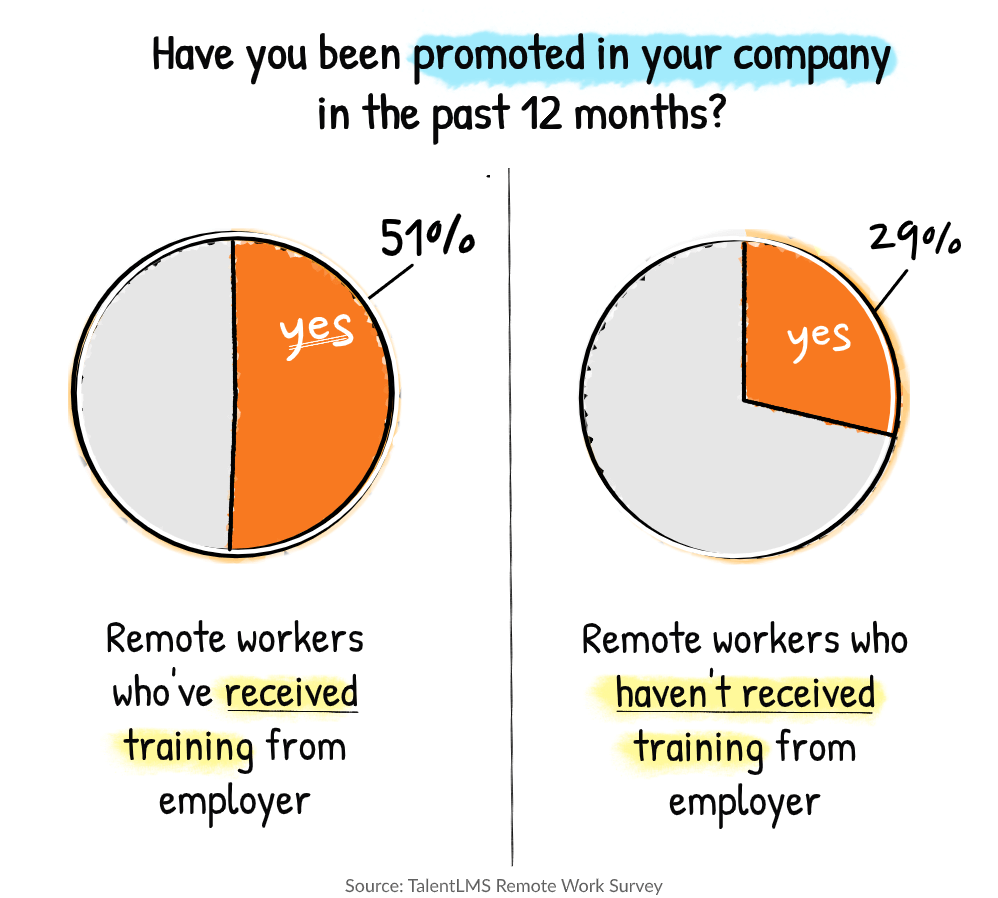
But what does this mean? Are those with training being promoted at much higher rates because they have more skills?
Not necessarily. We looked specifically at remote employees who hadn’t been given training by their employers but who had pursued training on their own in skills directly related to their roles. Only 35% of these respondents have been promoted.
It’s possible that receiving training isn’t the thing that causes employees to be promoted at a higher rate. Instead, it could be the other way around: being promoted results in employers providing these employees with training because they need help adjusting to their new roles.
In any case, encouraging a training culture within a company makes people stay. Companies that take the initiative to invest in their people’s training and development are also more likely to foster an environment of growth. And employees know this, with 72% saying that they’d be more likely to stay with their company in the long run if it provided training.
![]()
Remote work statistics — how work from home has changed from one year ago
Back in 2019, most of the employees we surveyed were working remotely by choice. And in the time before COVID-19, remote work looked different than it does today.
Now, 88% of survey respondents have recently transitioned to remote work as a result of the pandemic. How have remote workers of today changed the overall look and feel of working from home?
Finding motivation
Staying motivated throughout the day when working remotely is a challenge for new and experienced remote workers alike.
When asked what can help boost their motivation throughout the day, these were the top answers:
- #1 Listening to music (66%)
- #2 Chatting with a colleague (49%)
- #3 Exercising (46%)
And while these may seem like obvious answers, employers can leverage these findings when it comes time to return to the office. “Back to the office” doesn’t have to mean “back to the way things were.” Instead, employers can focus on combining the positive elements of working from home with working in the office.
That means focusing on apps or platforms designed to help keep communication open between employees and across departments, and even creating a dedicated space in the office for employees to take light exercise breaks.
All habits die hard
For some people, remote work has been a dream come true, while others can’t wait to get back to the office. As a result, both good and bad habits have increased since the start of the pandemic.
We asked remote employees which of the following they do more now, and here’s what they had to say:
- Watch TV (51%)
- Eat (50%)
- Exercise (42%)
- Talk on the phone (30%)
- Meditate (20%)
- Drink alcohol (18%)
- Smoke (16%)
Where remote work happens
2019’s remote work statistics report by TalentLMS revealed that 31% of people worked from their home office, and 27% from their living room. These respondents were remote workers by choice, as they were surveyed prior to the COVID-19 pandemic.
Despite 88% of this year’s respondents having transitioned to work from home as a result of COVID-19, the data shows a change in where remote work takes place. The number of people working from a home office has increased to 36%, as well as those working from the living room, which increased to 30%.
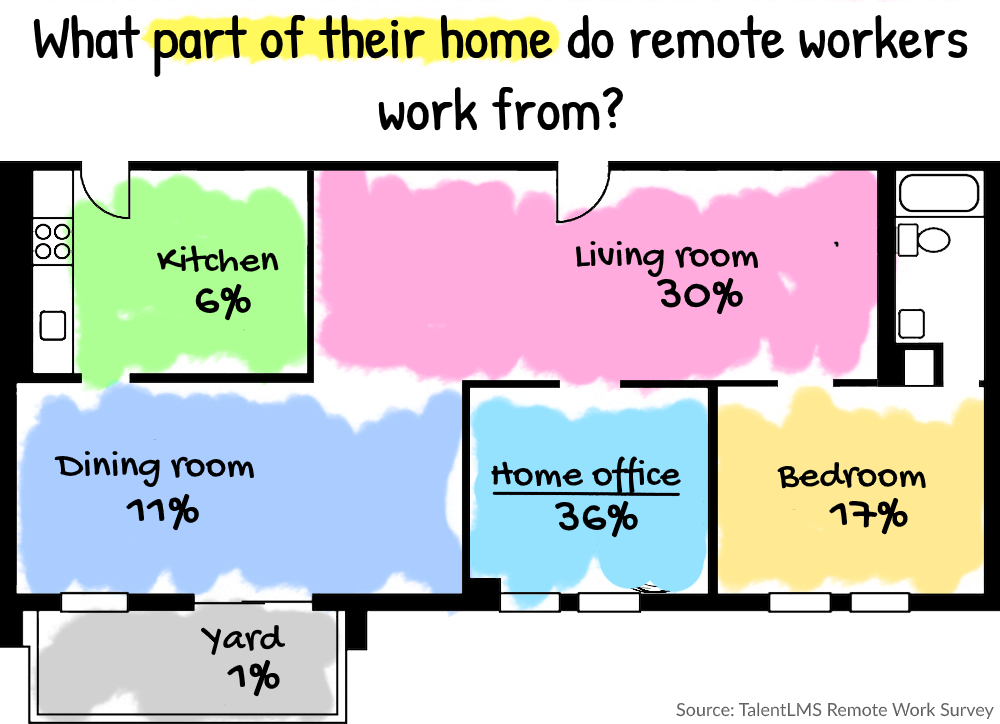
Fifty-nine percent of respondents have rearranged some area of their home to have a dedicated workspace, and 50% have bought furniture to help them work more productively, such as a desk, chair, or laptop stand. Some remote employees have taken things even further, with 16% reporting they have found somewhere else to work outside of their homes, and 6% actually relocating or moving homes.
All of these remote work statistics indicate that remote employees are shifting to more permanent work-from-home solutions instead of impromptu set-ups in their kitchens and dining rooms.
The golden hour of productivity
Despite the added flexibility that comes with working remotely, 40% of people report that they are most productive between the hours of 11 a.m. and 3 p.m. Thirty-one percent say they reach their productivity peak between 7 a.m. and 11 a.m., 22% between 3 p.m. and 7 p.m., and only 8% from 7 p.m. or later.
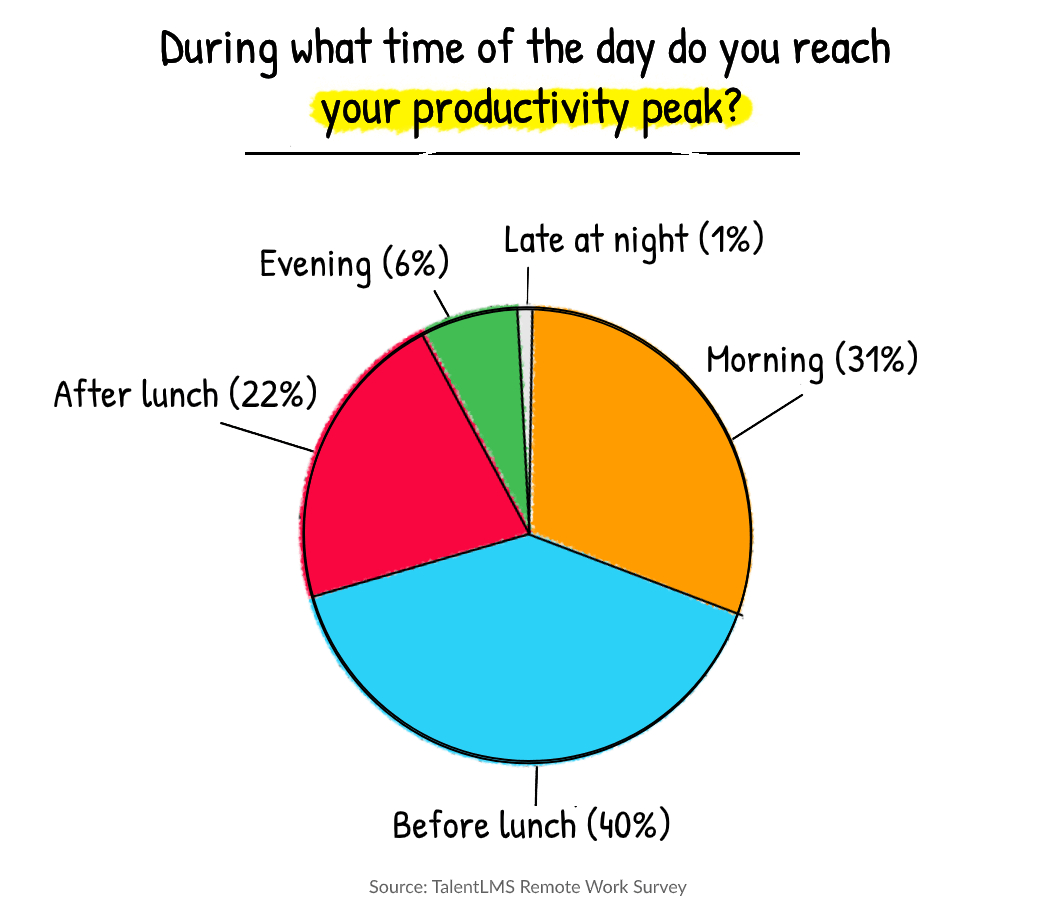
Dress codes are out
Office wear is out among remote employees, with 46% saying they wear something comfortable while working from home. Eighteen percent have adopted the new, professional on top, comfortable on the bottom look (also known as a Zoom outfit).
Even though many productivity experts suggest that dressing up is the right way to go when working remotely, only 17% still wear the same clothes they’d normally wear to work, while another 15% have opted for pajamas, and 4% for even less.
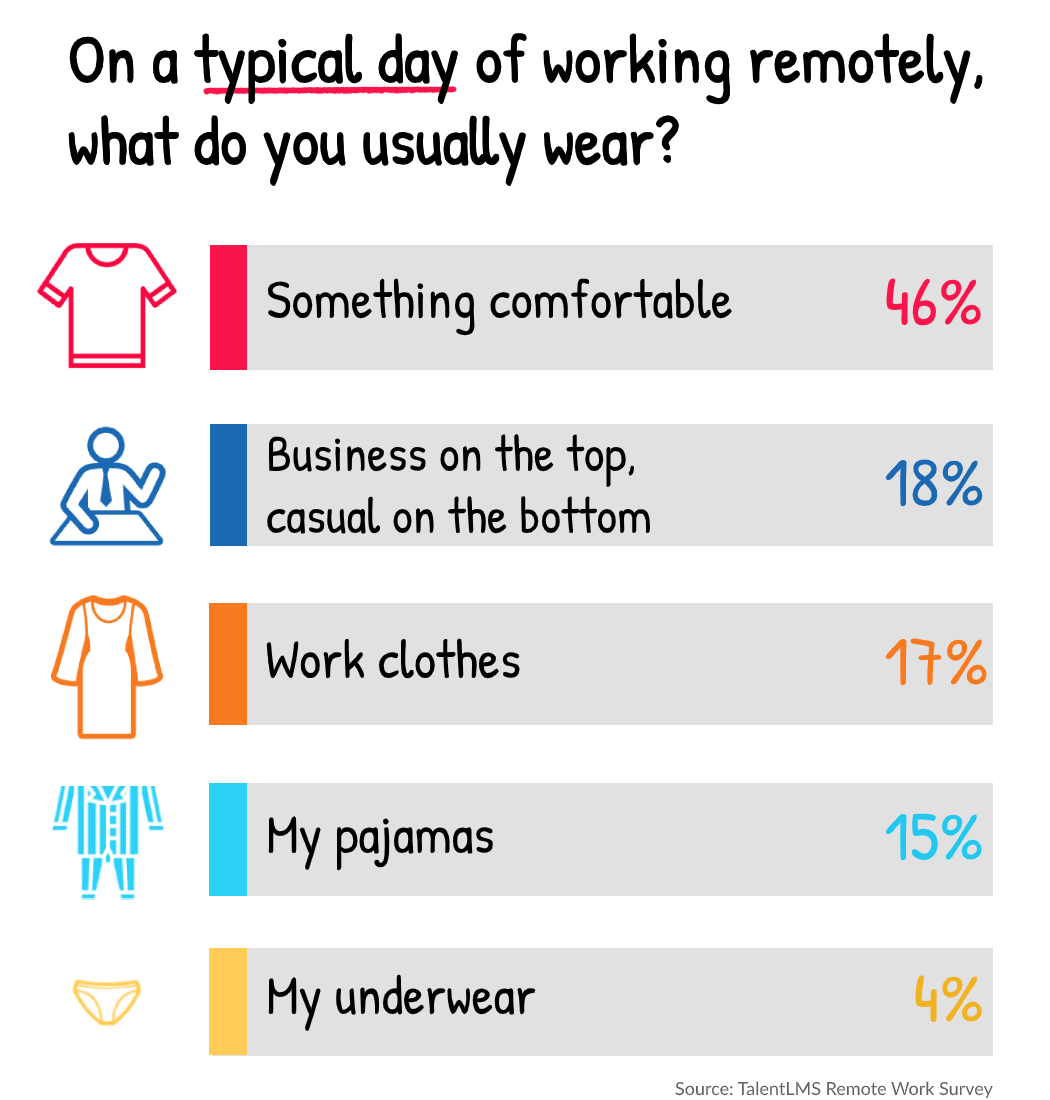
A different type of holiday bonus
It’s not uncommon for employers to offer their people special bonuses or end of the year perks. But since 2020 has been a different kind of year, the usual gifts may no longer apply.
We asked respondents to choose their top 3 perks they’d like to receive from their employers, and here’s what they had to say:
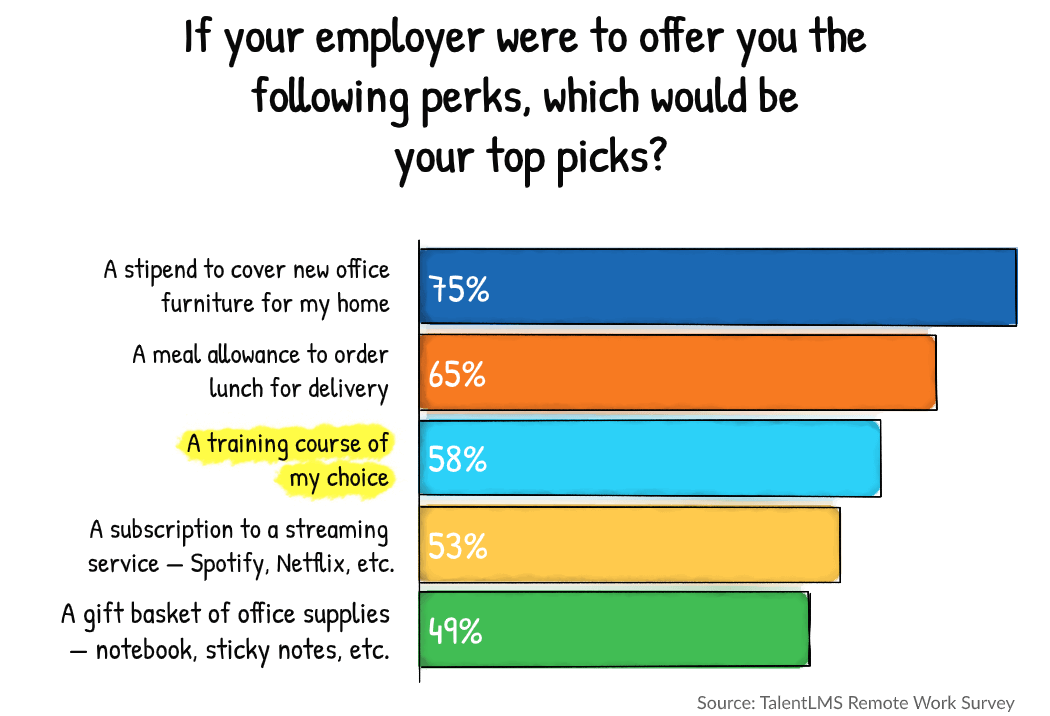
Work from home statistics: Putting faces to the numbers
If you’ve made it this far down the page, you’re likely a remote worker yourself, interested in working from home, or managing a remote team. Either way, we want to hear from you.
2020 has been a year no one was prepared for, but what do you have to say? What has helped you or your team advance, keep your workdays exciting, and maintain a healthy work environment? What part of your home do you work from? When do you feel most productive? What type of learner are you?
Share your knowledge in the comment section below, and help fellow remote workers out. After all, this is what we mean when we say we’re in this together.
Train your remote workforce with TalentLMS.
The training platform that users consistently rank #1.
Easy to set up, easy to use, easy to customize.
Useful work-from-home resources:
- Research: Knowledge workers are more productive from home – Harvard Business Review
- 40 remote work stats to know in 2020 – Hubspot
- Remote work statistics: Shifting norms and expectations – Flexjobs
- Work from home & remote work – Statistics & facts – Statista
- Remote work statistics: 9 stats that show telecommuting is the future – Miro
Originally published on: 07 Dec 2020 | Tags: Remote Employees,Remote Training
